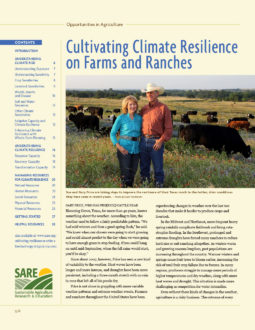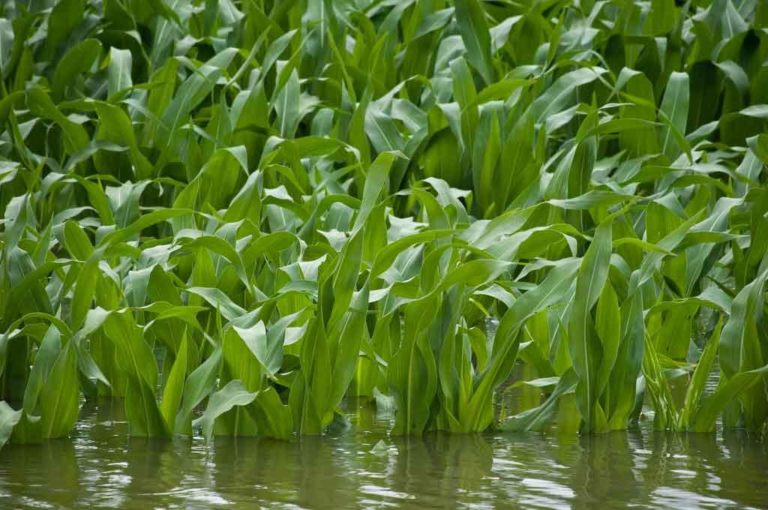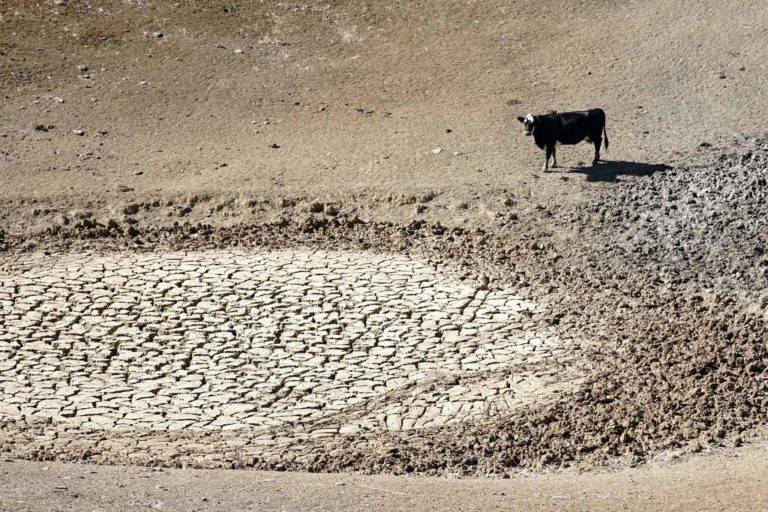Sensitivity refers to how the individual elements of the production system—crops, livestock, pests and diseases, land, infrastructure and people—respond to climate-related events. Because the sensitivity of your operation is a result of the interaction between the elements of your operation and the local climate challenges you may face, it is very place-based and farm specific. Sensitivity varies depending on the kind of crops or livestock you manage. For example, neighboring farms, one managing tree fruit and the other managing diversified vegetables, will not have the same sensitivity to warmer winters and more variable spring weather. On the fruit farm, a late spring frost during bloom has the potential to cause total crop loss, but on the vegetable farm it could actually increase crop yield and quality.
Crop Sensitivities to Climate
As weather patterns increasingly vary, the sensitivity of crops becomes more pronounced, forcing growers to adjust in various ways, often by changing the crops they grow or by altering the timing of their rotations. Already, in some parts of the country, heat waves and hot nighttime temperatures are disrupting fruit set in vegetable crops and reducing yields in grain crops. Warming winters and more variable spring weather are also disrupting crop development, especially in crops like winter grains and perennial fruits and nuts that require a dormancy period before flowering.
During the last 15 years, as summer temperatures increased and drought became more common, Alex Hitt started noticing a decline in production of some of his crops, particularly tomatoes. He grows four acres of vegetables and flowers in Graham, N.C.
“In 2012, high temperatures were near 100 degrees for more than two weeks in early June,” Hitt said. “We’ve had some heat-related pollination problems in tomatoes, squash, beans and cucumbers. Temperatures were just too hot for fruit set.” High fall temperatures have also caused problems, sometimes scalding the tomatoes on the vine. Drought has interfered with normal plant development, causing time to maturity to become more irregular.
In Missouri, the weather extremes of 2013 hit Shepherd’s pecan trees particularly hard. Spring flooding and drought through the summer stressed the trees and lowered yields. “Being underwater for a week or two really set them back,” he said. “And June 23 was the last rain we had until somewhere up in the middle of October, so that hurt the fill on the pecans.” Climate has a large influence on crop growth, yield and quality through seasonal patterns of temperature and precipitation. Plants are most sensitive to extremes of temperature and moisture during the reproductive phase in which flowering, pollination, fertilization and fruiting occur. The effects of temperature extremes are amplified by soil moisture extremes, which often occur together, such as a heat wave accompanied by drought.
| Table 2. Temperature Regimes of Some Annual Food Crops Grown in the United States Includes temperature ranges and optimum temperatures (degrees Fahrenheit) for germination, growth, and reproduction of selected annual food crops. Notice that optimum ranges for flowering and fruiting (reproductive) are cooler than the range for vegetative growth, and that flowering and fruiting fail completely at around 95 degrees for most crops. | ||||||
| Crop | Germination Soil Temp Minimum | Vegetative Growth Minimum | Vegetative Optimum | Reproductive Optimum | Reproductive Failure | |
| Corn | 50° | 46° | 77–91° | 64–72° | 95° | |
| Rice | 60° | 46° | 91° | 73–78° | 95° | |
| Wheat | 40° | 32° | 68–86° | 59° | 93° | |
| Soybeans | 50° | 45° | 77–98° | 72–75° | 102° | |
| Potatoes | 40° | 45° | 64–77° | N/A | N/A | |
| Onions | 37° | 45° | 68–77° | N/A | N/A | |
| Tomatoes | 55° | 53° | 68–77° | 59–68° | 95° | |
| N/A: The crop is not grown for its reproductive structure | ||||||
Every plant species has a set of optimum temperatures that best support its growth and development. These temperature optimums change through the phases of the plant’s life cycle. For example, lettuce seeds have an optimum soil temperature range of 43 degrees to 70 degrees, and they will not germinate at a soil temperature below 38 degrees. Lettuce plants can grow in air temperatures ranging from 45 degrees to 77 degrees, with an optimum between 64 degrees and 77 degrees. If the weather gets too hot, lettuce will grow poorly and harvest quality can greatly decline. Table 2 shows the temperature regimes of some important annual food crops.
If the temperature moves out of a plant’s optimum range, growth and development processes are slowed as the plant diverts resources to adjust to these adverse conditions. Plants can maintain some growth in temperatures outside of their optimum range, as long as the change is gradual, but that growth will be suboptimal at best. Signs that a plant’s growth is slowing due to temperature extremes include leaf rolling and wilting (due to heat), and reddish-purple leaf coloring and water-soaked leaves (due to cold).
For most crops, growth and development is more rapid as temperatures increase, but only until the upper limit of the optimum range. High temperatures reduce the quality and yield of annual crops and tree fruits as they ripen in the summer and fall, and complicate post-harvest handling such as cooling and packing. High temperatures and direct sunlight can sunburn developing fruits and vegetables, sometimes even scalding or cooking them while still on the plant.
In addition to temperature requirements, crops do best when the soil supplies enough water throughout the growing season to maintain healthy development despite changing environmental conditions. This need for adequate soil moisture is even more critical at high temperatures, just as people need to drink more water when they are outside on a hot day. Although plants have evolved many effective responses to maintain growth and development under conditions of variable soil water, many have critical growth phases during which too much or too little water can cause irreversible damage that greatly reduces crop quality and yield.
Limited soil moisture causes some plants to shift from vegetative to reproductive growth and complete their life cycle early, at much reduced seed yield and quality. Moisture shortages at later growth stages can likewise reduce both crop quality and yield. A continuous supply of water is particularly important for fruit and vegetable crops because optimum water availability increases fruit size and weight while preventing defects such as tough, cracked or misshapen fruit. Other common plant responses to drought include wilting, rolling, shedding and reducing the number and size of new leaves.
On the other hand, waterlogging during germination and the seedling stage often results in total crop failure. Many crops are very sensitive to waterlogged soil and can literally drown if the condition persists for more than 24 hours. However, there is considerable variation in crop tolerance to water-saturated soils. For example, depending on growth stage, soybeans can survive waterlogged conditions for only 48 to 72 hours, while corn can survive for two weeks and winter wheat nearly a month.
Like specialty crops and row crops, the productivity of grasslands and forage crops are also regulated by the interaction of seasonal patterns of temperature and moisture with local soil conditions. Given sufficient soil moisture, either from rain or irrigation, higher temperatures tend to increase grassland and forage production as long as temperatures remain within a productive range; however, if water is limited, high temperatures can reduce yields.
The same is not true for nutritional quality, which is determined by several interacting factors such as temperature, precipitation, soil nitrogen availability and carbon dioxide (CO2) levels in the atmosphere. Both increases and decreases in the nutritional quality of grasslands and forages have been observed in response to rising temperatures and CO2 levels. If soil nitrogen levels remain the same or decrease as temperatures and CO2 levels increase, these changes can stimulate plant growth and reduce protein content. Increasing CO2 levels combined with more variable water availability can reduce the protein content of grain crops. Rising temperatures and CO2 levels can also change the mix of species present in the grassland, which can increase or decrease forage quality. Given this degree of complexity, regularly monitoring pasture and forage yield and quality will become an increasingly important management tool.
Livestock Sensitivities to Climate
Like plants, animals have temperature and water requirements that support healthy growth and development, and their sensitivity to climate exposures varies over their life cycle (e.g., young animals are most vulnerable to temperature extremes). Temperature and water requirements vary by species and breed, and are influenced by physical traits (e.g., coat color or thickness). Unlike plants, animals can respond to environmental stresses, at least in some cases, by moving to a more comfortable location. For example, unconfined animals often seek shade as temperatures rise or move to sheltered areas during high winds or heavy rains. Note that the ability of animals to move to a cooler area is not possible in confined feeding operations, such as is typical of poultry, hogs and often cattle being fattened with grain for eventual slaughter.
Because well-managed livestock typically receive adequate water and food, the key climate sensitivities in livestock systems are extreme temperature and humidity. Livestock can acclimate to gradually changing temperatures, but long periods of temperature extremes or extreme or rapid fluctuations in temperature will reduce productivity and can sometimes result in death. Combinations of wet conditions, cold temperatures and wind during the spring birthing period, a particularly sensitive time in the life of an animal, can present significant challenges to producers managing livestock outdoors.
At Sap Bush Hollow Farm near Cobleskill, N.Y., where Jim Hayes produces lamb, beef, pork and poultry on 160 acres of pasture and woodlands, heavy rains have grown more common over the past 15 years and have increased surface water flows and ground saturation. “We were getting quite a bit of flow down the valley and quite a bit of groundwater coming up and saturating the areas where we keep the livestock during the winter,” Hayes said. So, he built a new drainage system to redirect surface runoff and a new barn with a raised concrete floor to provide dry shelter for livestock.
Livestock producer Ron Rosmann suspects that increased weather variability, especially extreme temperature swings in winter, are creating stress in his cattle. He produces feed and food grains, beef, pork and poultry on 700 acres in the rolling hills of western Iowa near Harlan. “It used to be that the cattle could tank up on feed because you could count on the cold spell hanging around a couple weeks,” Rosmann said. “Now we’ve got 50-, 60-degree swings in a matter of days, plus you throw the wind in. That’s the biggest change I’ve seen in my lifetime. We’ve always had those variations but not continually. You’d have longer periods in between. These extreme swings are hard.”


